(Q6 on my birth plan – positions for labour)
(Q9 I would like to be in the following position to give birth:)
I sat in a hospital waiting room during my first pregnancy, waiting to see someone when a couple came in looking for labour ward. Her waters had broken and they were trying to find out where to go. They waited for the receptionist, and while doing so, were looking at the posters on the wall. The one just beside me had a whole variety of labour positions depicted in pictures. The woman said to her partner, “Hey, look here. You can have the baby in all these positions. You don’t have to lie down.”
My jaw dropped.
I’m sorry if this sounds judgemental, but I struggle to fathom how you can get to that point in one of the biggest occasions in your life and not know something as simple as labour positions. Especially when your position during labour can have such a huge impact on your experience of childbirth.
Humans are the only mammals that try to give birth on their backs. It’s illogical as it defies gravity.
In The Business of Being Born, Michael Odent, the reknown doctor from France, explains why doctors want women on their backs – it makes their job of observing and interfering much easier. He shows, in the video, the best position for a woman, which has him low down –hard on his back, but better for the labouring woman.
In reality, the best position for a labouring woman is the one she’s comfortable in. I spent most of my pregnancy with Ameli practicing squatting so I could give birth in that position. I also highly recommend every woman choosing a home birth to hire a maternity nurse. When it came down to it though, I found having my back out of the water to be excruciating and ended up delivering in the pool, sitting bolt upright. An illogical position, but a perfect one for me. Below are a few suggestions for the best positions to labour in. The links go to videos with detailed instructions on each position. (Some videos are linked more than once.) I’ve also collaborated with Joni Rae from Kitchen Witch who has drawn up two beautiful printable pages for you to print out and keep with your birth plan to remind yourself of the different positions when the time comes. Feel free to print and share them, but please remember to attribute them to her. There are two of the same of each, with different spellings of labour/labor. Choose whichever you prefer!
[pinit]
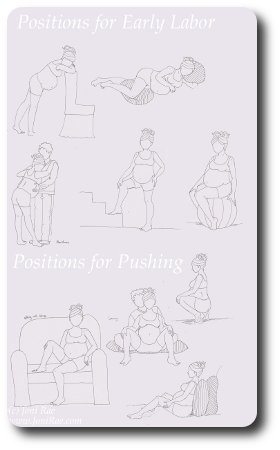
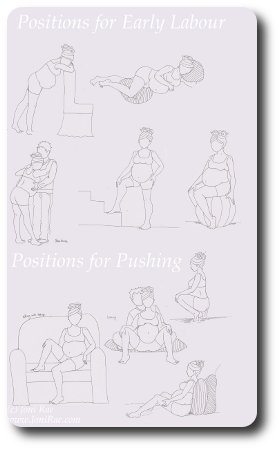
IF the link on the images don’t work, please use these below:
UK Positions for Labour and Pushing
US Positions for Labour and Pushing
[pinit]
First stage/Early Labour
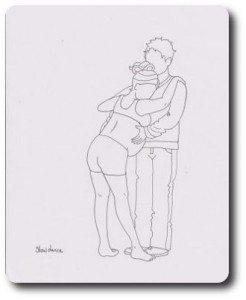 Side lying – especially with a pillow between your knees, helps open the pelvis. (After 44 hours of labour and progressing only to 4cm, two hours in this position saw me go from 4 to 8cm and my daughter was born an hour later.)
Side lying – especially with a pillow between your knees, helps open the pelvis. (After 44 hours of labour and progressing only to 4cm, two hours in this position saw me go from 4 to 8cm and my daughter was born an hour later.)- Leaning forward – useful for taking the weight of the baby off your back
- Rocking, swaying and rhythmic motion – slow dance with your partner to help you relax and release the birthing hormones. Alternatively, there’s been great things said about gentle belly dancing during labour. Another option is sitting on a birth ball and doing figure of eights with your hips.
- To progress labour, staying active is helpful. For example, climb stairs, go for a walk, do lunges – these are useful to have practiced in late pregnancy so as not to be exhausted with sore muscles! Walking uses gravity and contractions are often less painful. It may speed up labour, reduce backache and encourages descent.
Back labour 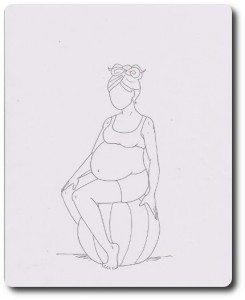 Back labour generally inspires fear. Everyone accepts widely that it is more painful, although that’s not a given. For me, it was. I couldn’t lie down, and if I wasn’t submerged in water, I found it excruciating. This time I want to be prepared with more back labour defences! (I also have always had back pain during periods, so have always anticipated back labour in childbirth.) The idea with these positions is to keep the baby away from the spine, taking the pressure and weight off the spine. These positions can also help baby move from a posterior position.
Back labour generally inspires fear. Everyone accepts widely that it is more painful, although that’s not a given. For me, it was. I couldn’t lie down, and if I wasn’t submerged in water, I found it excruciating. This time I want to be prepared with more back labour defences! (I also have always had back pain during periods, so have always anticipated back labour in childbirth.) The idea with these positions is to keep the baby away from the spine, taking the pressure and weight off the spine. These positions can also help baby move from a posterior position.
- Over the birth ball or bed – helpful if baby stays back to back, and good for pelvic rocking(tilt) which helps with pain relief.
- Pelvic Tilt
- Straddle a chair
- Leaning against a wall is great for rotating a posterior presentation, and the contractions are often more productive.
- Sofa or raised hospital bed
- Lunges
Positions for pushing
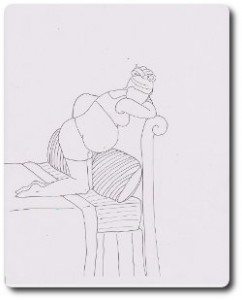 Semi-sitting – Good for resting, uses gravity – this is how I gave birth, as it was the most comfortable position for me.
Semi-sitting – Good for resting, uses gravity – this is how I gave birth, as it was the most comfortable position for me.- Side-lying – you’ll probably need someone holding your leg up for this one. This is good for fetal oxygenation. This position may promote progress of labour (I went from 4-8cm in two hours in this position – after 44 hours at 4cm)
- Hands and knees – this is a popular home birth position, also useful because mothers often deliver their own babies in this position. This position is also good if there’s low heart tones, and takes pressure off of haemorrhoids. This is apparently a good position for delivering a large baby, and excellent for shoulder dystocia.
- Back of hospital bed or sofa – similar to hands and knees, but with support
- Birth ball – again, similar to the above
- Squatting – this one takes strong legs and practice, but is great for shortening the birth canal and also for delivering your baby into your own hands. Also increases pelvic diameter by up to two centimeters.
- Dangle – is pretty much identical to squatting, with the difference being that someone else (and strong!) supports your weight. This is similar to a birthing stool, except your centre of support is different. (There has been mention of dangling putting too much pressure on the perineum, so do what’s comfortable.)
Sources: Lavender T and Mlay R. Position in the second stage of labour for women without epidural anaesthesia: RHL commentary (last revised: 15 December 2006). The WHO Reproductive Health Library; Geneva: World Health Organization. Copyright © Paulina G. Perez, RN, BSN, LCCE, FACCE, Lamaze Parents Magazine. Positions for Labor and Birth – Transition to Parenthood Images: Joni Rae from Kitchen Witch
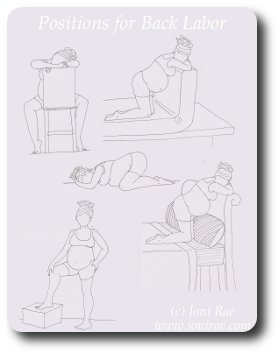
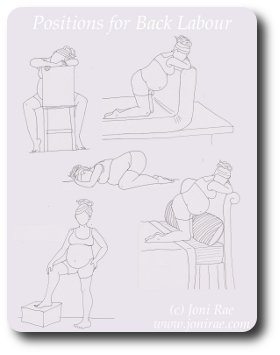
This is fabulous! Thank you. I am making a birth book for my first child due in a few weeks. Printing this out and adding it for future reference.
So glad you like it, and I’m sure you’ll find it useful! Best wishes xx
I love these! Can I use them for childbirth classes to pass out to students?
Of course you can Emily, but please keep the credit to myself and Joni Rae on the images! So glad you like them!
I gave birth to our daughter while in a half squat, half kneeling position while leaning on the side of the bed (I was on the floor). I tried many, many positions and that was the one that felt right. Turned out to be right because she had a nuchal hand on the same side that I was squatting on while the other side didn’t that I was kneeling on. No tearing!
My first was a hospital birth–induced for preeclampsia. I couldn’t move myself at all so I ended up on my back with feet in the stirrups. He was posterior, and I still didn’t tear, but I attribute that to the fact that I “fake” pushed while they were yelling at me and only really pushed when my body told me to (no epidural).
What a fantastic post! I came across your blog the other day, via a link provided by a doula friend. I love it, and you’ve now got a new fan!
One small thing, I pinned this post so I could come back to it to print out the labor position sheets, but the links no longer work. Can you help me out?
Hi Heather. I’m so glad you like it. It’s always fantastic to hear 🙂 I have no idea why the labor positions sheets pins aren’t working! I haven’t changed anything! Let me look into it and get back to you!
Hi Heather – this should be fixed now. I have no idea why it unlinked! Thanks for letting me know though!
I can’t wait for my next birth so I can be in different positions… I was laying down for my only birth so far. =( It was pretty awful, I wanted so badly to move, because I felt like I couldn’t push effectively at all. But I had an epidural and it wasn’t working properly but was working enough so that I couldn’t support any weight on my legs…
This is a great post, to the point and accompanied by Joni’s beautiful drawings! Love!
This is gorgeous Luschka, thanks so much for sharing. I was one of those woman that was totally unaware of different labour positions *blush*. I was totally unprepared and naive, hope to be much better prepared next time! 🙂
Brilliant post, Luschka! I knew about good positions, but with Rosemary I was made to lie on my back – which I blame for a lot of the problems we had (that and the pethedine I was somehow talked into taking before Chris arrived). With Eleanor, I was very lucky to have a fabulously supportive midwife who knew what I wanted and helped me to achieve it – water birth kneeling with my arms on the side. She (and the other midwife, who was great too) basically said that I needed to get in the position that was comfortable for me and they would catch her whatever happened. A thousand times more positive experience.
Wishing you way in your last few weeks. Tasha xxx